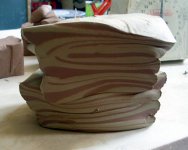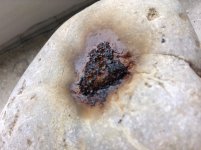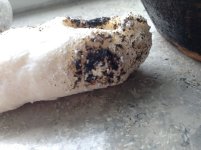entheogenic-gnosis
Rising Star
I'm sure most of you remember making "plastic" (it's actually casein in this case, true plastic is polymer composed) from milk, from your middle school chemistry coarse, anyway this material can be useful, though I never thought of it as being suitable for something such as pipe making until briefly reviewing this article...
In the article below making tobacco pipes from casein is discussed.
Though it seems after the casein is derived from milk that it is soaked in formaldehyde...
so, if I took some milk, heated it, mixed the heated milk with acetic acid (vinegar), then filtered this through a strainer collecting the formed solids (casein), which were then soaked in formaldehyde and dried I would have a material suitable for building tobacco pipes?
The formaldehyde soak should make the casein resistant to high heat, though I'm uncertain if this new material is any stronger than the initial casein...
a fascinating and simply available material, I'm thinking I could make pipes, ashtrays, etc...Though this doesn't seem like a very good "long-term" material, it could be used to make wares for sell (I also make jewelry from ayahuasca vines and hemp cord, as well as t-shirts, tie-dyes, and I'm learning how to make dyes from my entheogens, a UV reactive dye from peganum harmala, purple dye from mimosa hostillis, etc...)
so if this casein-formaldehyde is a viable material for producing the type of wares which I support myself with, I think it would be worth looking into...
------
(Article)
Casein
Casein, in full casein-formaldehyde, consists as the name suggests of an important part of the milk protein. Casein can be extracted from skimmed milk with a specific enzyme. By exposing the kneadable doughy substance to the liquid formaldehyde for days or even weeks a new material emerges, which will not melt, even at high temperatures.
It is a so-called thermosetting synthetic material, like rubber (semi-synthetic). The patent for the production of this material dates from 1899 and belonged to the Germans Krische and Spitteler. They called the new material Galalith. Later it became known also as Erinoid, Ameroid and Kasolid. Casein can be coloured easily. A drawback of the material is its sensitiveness to liquid. Long-term exposure to liquid makes the material crack.
The pipe-making industry used the material widely till after the Second World War for the production of cigarette pipes (pipettes), as it could easily be pierced, turned or modeled. The long Charleston cigarette pipes of the 1920’s are made of casein.

------
-eg
In the article below making tobacco pipes from casein is discussed.
Though it seems after the casein is derived from milk that it is soaked in formaldehyde...
so, if I took some milk, heated it, mixed the heated milk with acetic acid (vinegar), then filtered this through a strainer collecting the formed solids (casein), which were then soaked in formaldehyde and dried I would have a material suitable for building tobacco pipes?
The formaldehyde soak should make the casein resistant to high heat, though I'm uncertain if this new material is any stronger than the initial casein...
a fascinating and simply available material, I'm thinking I could make pipes, ashtrays, etc...Though this doesn't seem like a very good "long-term" material, it could be used to make wares for sell (I also make jewelry from ayahuasca vines and hemp cord, as well as t-shirts, tie-dyes, and I'm learning how to make dyes from my entheogens, a UV reactive dye from peganum harmala, purple dye from mimosa hostillis, etc...)
so if this casein-formaldehyde is a viable material for producing the type of wares which I support myself with, I think it would be worth looking into...
------
(Article)
Casein
Casein, in full casein-formaldehyde, consists as the name suggests of an important part of the milk protein. Casein can be extracted from skimmed milk with a specific enzyme. By exposing the kneadable doughy substance to the liquid formaldehyde for days or even weeks a new material emerges, which will not melt, even at high temperatures.
It is a so-called thermosetting synthetic material, like rubber (semi-synthetic). The patent for the production of this material dates from 1899 and belonged to the Germans Krische and Spitteler. They called the new material Galalith. Later it became known also as Erinoid, Ameroid and Kasolid. Casein can be coloured easily. A drawback of the material is its sensitiveness to liquid. Long-term exposure to liquid makes the material crack.
The pipe-making industry used the material widely till after the Second World War for the production of cigarette pipes (pipettes), as it could easily be pierced, turned or modeled. The long Charleston cigarette pipes of the 1920’s are made of casein.
------
-eg





